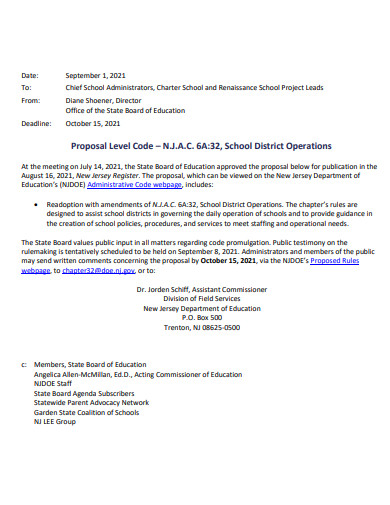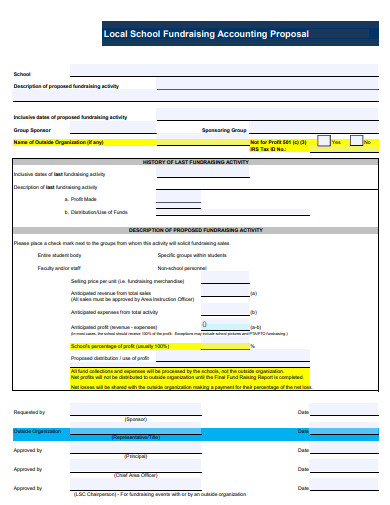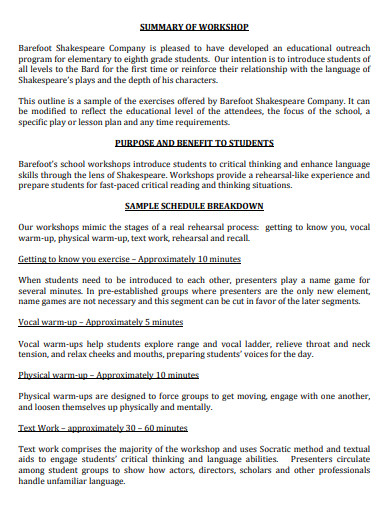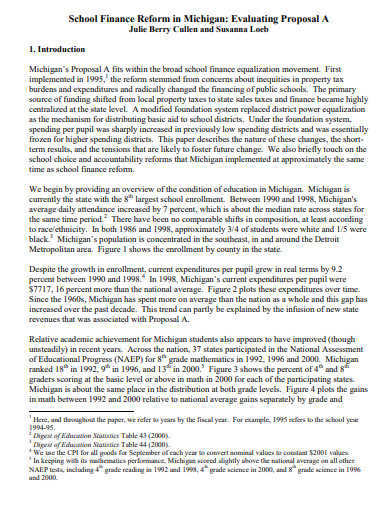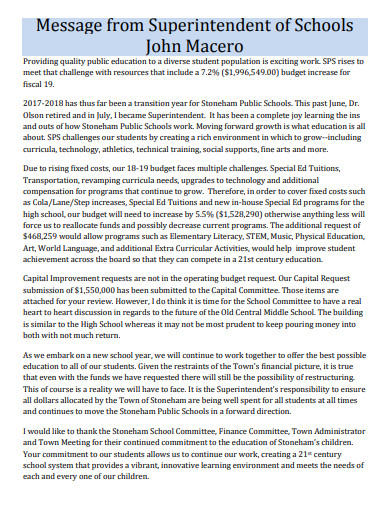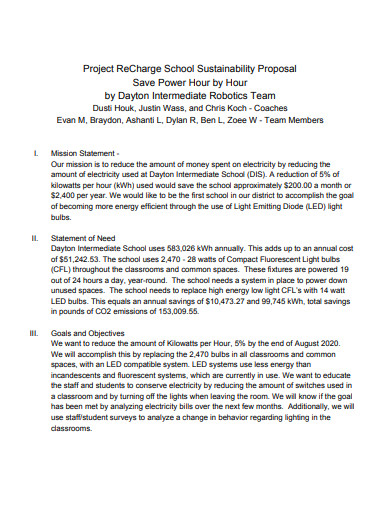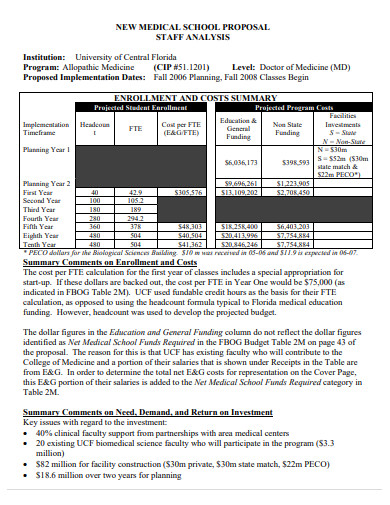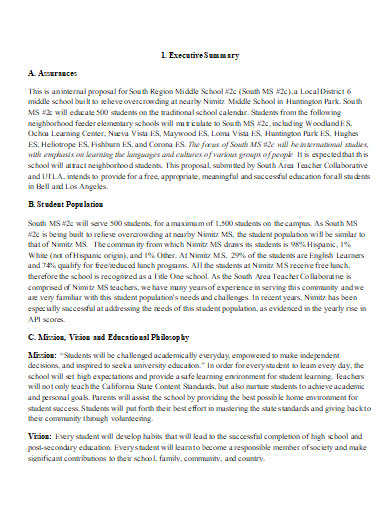The purpose of an education proposal is usually to secure grant money and get approval for a specific education project. Often, an entire team is involved and will collaborate to put the proposal together. Whether it’s the idea of one person or of many, a proposal for an education project generally follows a basic format.Writing a proposal for a school project can be just as time-consuming as doing the project. But if you follow a good outline, you won’t have to reinvent the wheel. Most proposals – whether for professional business projects or school projects – require the same information, so once you learn the style, you’ll be ahead of the class.
10+ One Page School Proposal Samples
1. One Page School Proposal
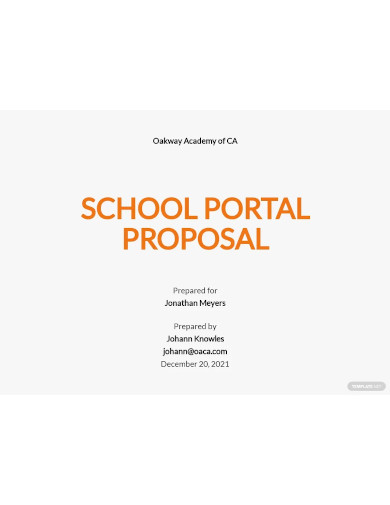
2. One Page Elementary School Proposal
3. Sample One Page School Proposal
4. Local School Fundraising Accounting Proposal
5. One Page School Nutrition Proposal

6. One Page School Workshop Proposal
7. School Finance Evaluation Proposal
8. One Page School Budget Proposal
9. One Page School Project Proposal
10. New Medical School One Page Proposal
11. Printable School One Page Proposal
What is a One Page Proposal?
A one-page proposal is a document sent during the business proposal stage of your sales process outlining the deal terms with a prospective customer. A one-pager typically includes the following sections: proposal scope, project overview, deliverables, cost, timeline, terms, next steps, and contact information. It’s used when a longer proposal isn’t needed and can be sent physically, as an email attachment, or in the body of an email itself.
How to Make a One Page School Proposal
1. Start With an Abstract
The abstract is a concise paragraph or a single page that explains the entire purpose and scope of the proposal. Similar to a blurb on the back of a book, the abstract gives you a short version of the whole. Abstracts help to focus readers and guide them through the proposal. While the proposal starts with an abstract, some people find it easier to write this section last so it essentially acts as a summary of the entire report.
2. Write the Needs Assessment or Statement of the Problem
There is a reason you are proposing this plan or idea – to fulfill a specific need or solve a problem – so the first section should clearly explain what the need is or describe the problem that will be solved. This section is very important, and the content should be clear and concise. For example, you are proposing a program to improve the math scores of eighth-grade students. Describe the current state of their grades and show why these students would benefit from your program.
The needs assessment section should also explain how you’ve analyzed the needs of this particular group and why the implementation of the project will be helpful. How did you identify the eighth-grade project participants? How did you determine that your project could be successful with this group? Don’t describe the entire project or plan in detail here. That comes next.
3. Include the Program Description
Now you’ve come to the meat of the proposal. What exactly is your proposed idea? Describe the nature of the project and show how it will lead to improving student performance. It’s a good idea to keep the focus of the project limited so it can be implemented effectively within the time and budget constraints of the project. In this section, also include the project’s goals and objectives. Explain what you plan to achieve and lay out the timeline.
4. Describe How the Project Will Be Implemented
The implementation section provides a more detailed explanation of how exactly you will operate the project. You gave a brief outline of this in an earlier section, but here is your chance to further explain the objectives, activities, instructional methods, materials and assessments that will be essential for the implementation and evaluation of the project.
5. List the Key Personnel
Identify each member of the project team and describe their duties and responsibilities. Indicate the amount of time this team will devote to the project. Provide a short bio for each team member, highlighting their backgrounds and achievements and revealing why they are a good fit for this project.
6. Budget and Justification
In this section, create a detailed budget. State the total amount you are requesting, then break down the spending for each part of the project. For our eighth-grade math example, this could include staff salaries, computers and other related costs.
7. Methods and Measurement Tools
Describe exactly the methods you will use to measure the success or failure of the project. It is important to connect the ideas in this section to the rest of the plan. This section should illustrate the strategies you plan to use to determine the extent to which you are attaining the project’s objectives. List the data you plan to collect and the assessment measurements you will use. Provide a timeline for collecting the data and explain your strategies for compiling and reporting evaluation results.
Education proposals are typically long and very detailed. They also involve lots of initial research and revision. This is a nutshell version of how you can put one together, but any successful proposal for a major project should be thorough and well-written.
FAQs
What to do when a one page proposal is too long?
Identify the essential elements and remove the rest. Remember, your proposal must answer these six questions succinctly:
- Who is the proposal from?
- What is the project scope?
- What will you deliver?
- Why is your recommended solution best?
- What are the estimated timelines for the project?
- Where is the point of delivery?
Also, look for ways to shorten sentences or communicate effectively with fewer words. If you need help, ask a colleague to look it over and make suggestions.
When should one send a one-page proposal rather than a full proposal?
Use a one-page proposal when information can be easily simplified, when you want to stand out from the competition, and, of course, when requested. If you feel you need a full proposal, you can always send a one-pager with a note that the full project proposal is on the way or you can standardize most of your proposal information and send it as supplemental attachments.
Related Posts
FREE 13+ Education Project Proposal Samples in MS Word Pages ...
FREE 9+ Business Loan Proposal Samples in PDF MS Word
FREE 9+ Event Planning Proposal Samples in PDF MS Word
FREE 10+ Student Project Proposal Samples [ Management ...
FREE 9+ Email Marketing Proposal Templates in PDF MS Word
FREE 3+ Medical Training Proposal Samples in PDF Apple Pages
FREE 10+ School Program Proposal Samples [Summer, Project ...
FREE 18+ Grant Proposal Samples in PDF MS Word | Pages ...
FREE 17+ Funding Proposal Samples in PDF MS Word | Pages ...
FREE 12+ Best Loan Proposal Samples in MS Word PDF | Pages ...
FREE 10+ School Business Plan Samples in PDF Apple Pages
FREE 17+ Project Proposal Samples in PDF MS Word | Pages
FREE 10+ School Budget Proposal Samples [Library, Garden, Project]
FREE 15+ Sample Photography Proposal Templates in PDF Pages
FREE 10+ Title Project Proposal Samples [ Community, School ...


